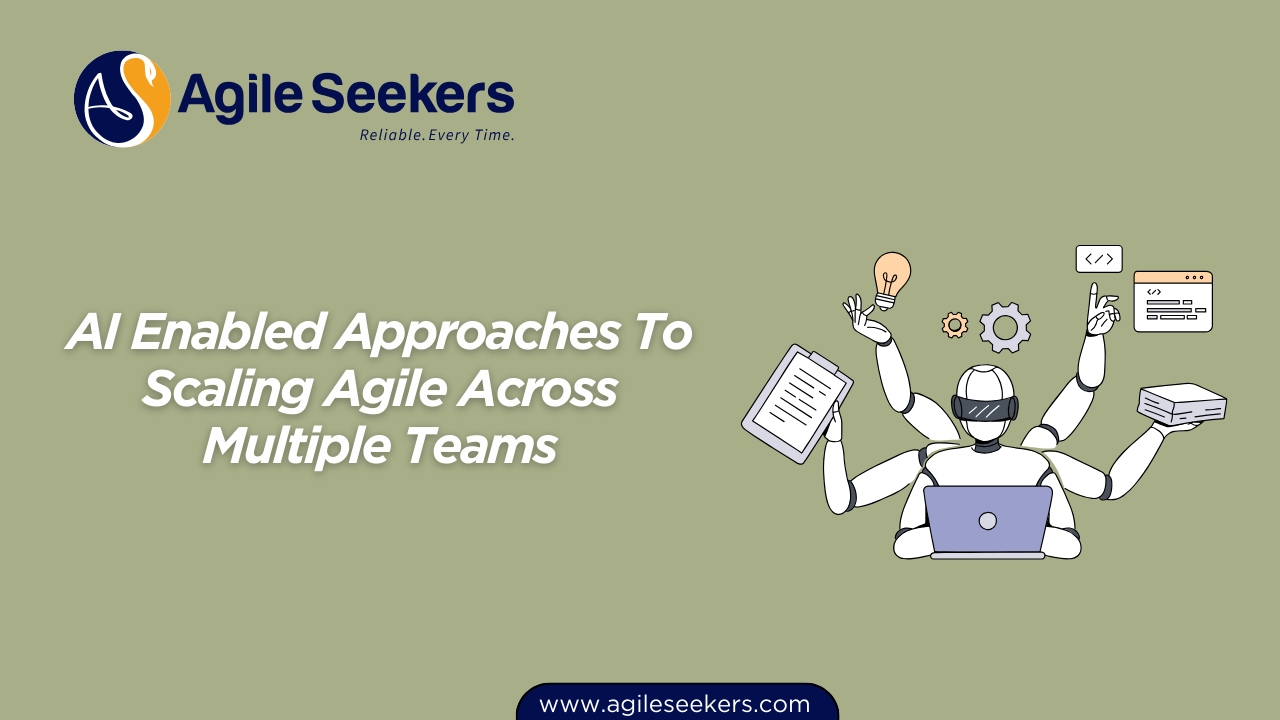AI Enabled Approaches To Scaling Agile Across Multiple Teams

Scaling Agile isn’t just about multiplying stand-ups and sprint boards. Once you move beyond a single team, the complexity rises fast dependencies, communication gaps, and competing priorities start pulling in different directions.
AI tools can cut through that complexity, making coordination across multiple teams smoother, faster, and more informed.
This guide breaks down how AI-enabled practices can help leaders scale Agile without losing alignment or speed.
1. Why Scaling Agile Is Hard Without AI Support
When you scale Agile across several teams, three pain points show up consistently:
-
Visibility – Data is scattered across tools, boards, and teams.
-
Dependency Management – Blockers aren’t spotted until they’ve already slowed delivery.
-
Prioritization Drift – Strategic goals get diluted as you move further down into execution layers.
Traditional portfolio or program management tools can track tasks, but they don’t interpret what’s going on. That’s where AI changes the game — by surfacing patterns, predicting risks, and offering recommendations instead of just showing status.
2. AI’s Role in Scaling Agile
AI helps connect strategy with execution across multiple teams by:
-
Consolidating and analyzing data from Jira, Azure DevOps, Trello, Confluence, and other tools in real time.
-
Spotting bottlenecks before they impact milestones.
-
Recommending backlog priorities based on business value, customer impact, and delivery risk.
-
Improving decision-making with predictive analytics on delivery timelines and quality outcomes.
Leaders trained in AI for Agile Leaders and Change Agents Certification can take advantage of these capabilities to make scaling Agile less about firefighting and more about orchestrating flow.
3. AI-Driven Backlog Alignment
One of the biggest challenges in scaled Agile is keeping backlogs aligned across teams and ARTs (Agile Release Trains). AI tools can:
-
Analyze user feedback and market data to feed the backlog with relevant, high-value features.
-
Map backlog items to strategic objectives automatically.
-
Highlight conflicting priorities so leaders can course-correct early.
For example, AI-enabled backlog refinement can identify when two teams are working on similar features and suggest merging them to avoid duplication.
4. Cross-Team Dependency Prediction
Dependencies kill momentum in scaled environments. AI can scan sprint plans and project schedules across all teams to:
-
Detect hidden dependencies before they become blockers.
-
Suggest sequencing changes to reduce idle time.
-
Automatically notify impacted teams when upstream tasks slip.
This transforms dependency management from reactive to proactive — exactly what’s needed when scaling Agile.
5. AI-Enhanced Program Increment (PI) Planning
PI planning is already a cornerstone in frameworks like SAFe, but AI can elevate it by:
-
Simulating different planning scenarios to see the downstream effects of resource shifts.
-
Predicting delivery risk based on past performance patterns.
-
Optimizing team allocation using capacity, skillsets, and work type balance.
External resources such as the Scaled Agile Framework’s PI planning guidelines offer a good foundation, but integrating AI tools into the process makes it more adaptive and evidence-driven.
6. Automated OKR Tracking Across Teams
When scaling Agile, OKRs (Objectives and Key Results) need to be monitored across multiple workstreams. AI helps by:
-
Continuously tracking progress against OKRs without manual reporting.
-
Flagging at-risk objectives based on velocity and blocker trends.
-
Suggesting backlog reordering to keep objectives on track.
7. Continuous Flow and Performance Monitoring
AI-powered dashboards go beyond burndown charts. They provide:
-
Real-time flow metrics like throughput, lead time, and defect escape rate.
-
Anomaly detection to catch dips in performance before they become trends.
-
Root cause insights linking metrics to specific process changes or events.
These insights help release train engineers, product managers, and leadership teams steer the ship without waiting for end-of-sprint retrospectives.
8. Intelligent Retrospectives Across Multiple Teams
At scale, retrospectives can generate more feedback than anyone has time to read. AI text analysis can:
-
Summarize key themes from all team retros.
-
Identify cross-team issues worth addressing at the program level.
-
Spot repeating patterns over multiple increments.
This ensures the learning loop is tight, even in large-scale environments.
9. AI-Supported Change Management
Scaling Agile is as much about culture as it is about process. AI can help change agents and leaders:
-
Analyze sentiment from team chats, emails, and feedback forms.
-
Identify teams that may need targeted coaching.
-
Suggest training or process adjustments that have worked in similar contexts.
These capabilities align closely with the leadership skills developed in AI for Agile Leaders and Change Agents Certification, helping leaders adapt their coaching and facilitation style based on real data.
10. Building Your AI-Scaling Roadmap
Here’s how to introduce AI into your scaled Agile environment without overwhelming teams:
-
Start small – Pick one area like backlog prioritization or dependency tracking.
-
Integrate with existing tools – Avoid forcing teams to learn entirely new systems.
-
Focus on enablement, not replacement – AI should enhance team decision-making, not replace it.
-
Measure impact – Track metrics before and after AI adoption to prove value.
-
Scale gradually – Expand AI usage to other processes once you’ve validated results.
Final Thoughts
AI isn’t a magic switch for scaling Agile, but it can drastically reduce friction across teams and keep large-scale initiatives aligned with strategy. Leaders who understand both Agile principles and AI capabilities will be in the best position to drive this transformation.
If you want to develop the skills to lead AI-powered Agile at scale, explore the AI for Agile Leaders and Change Agents Certification. It blends leadership techniques with AI application strategies so you can scale Agile with confidence and precision.
Also read - Building Transparent AI Strategies That Support Agile Values
Also see - How PMOs And RTEs Can Benefit From AI In Leadership Roles




















